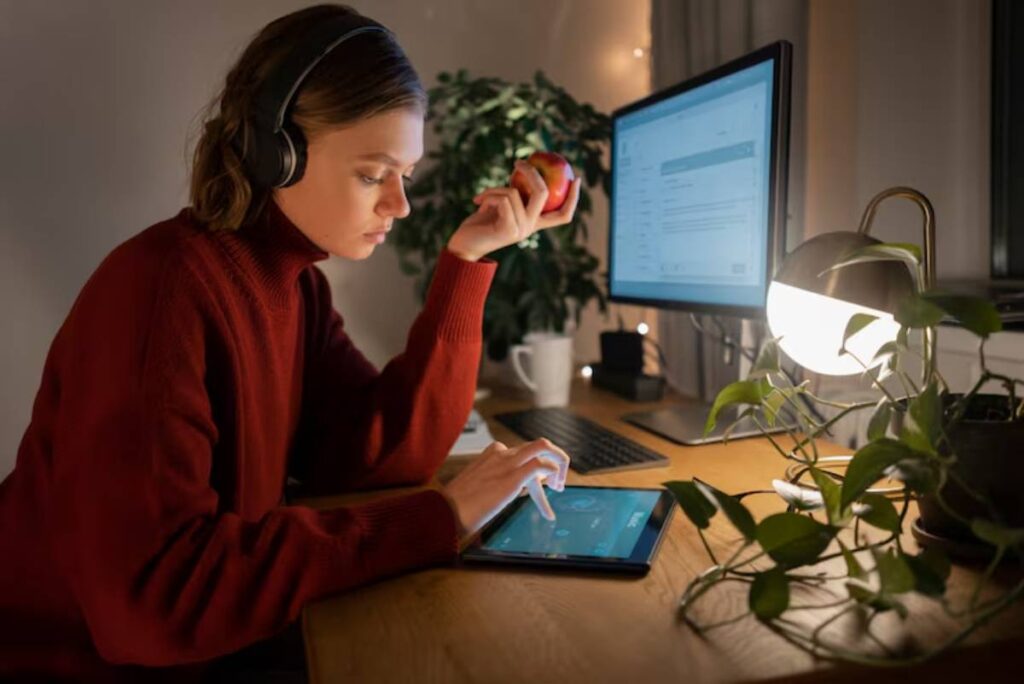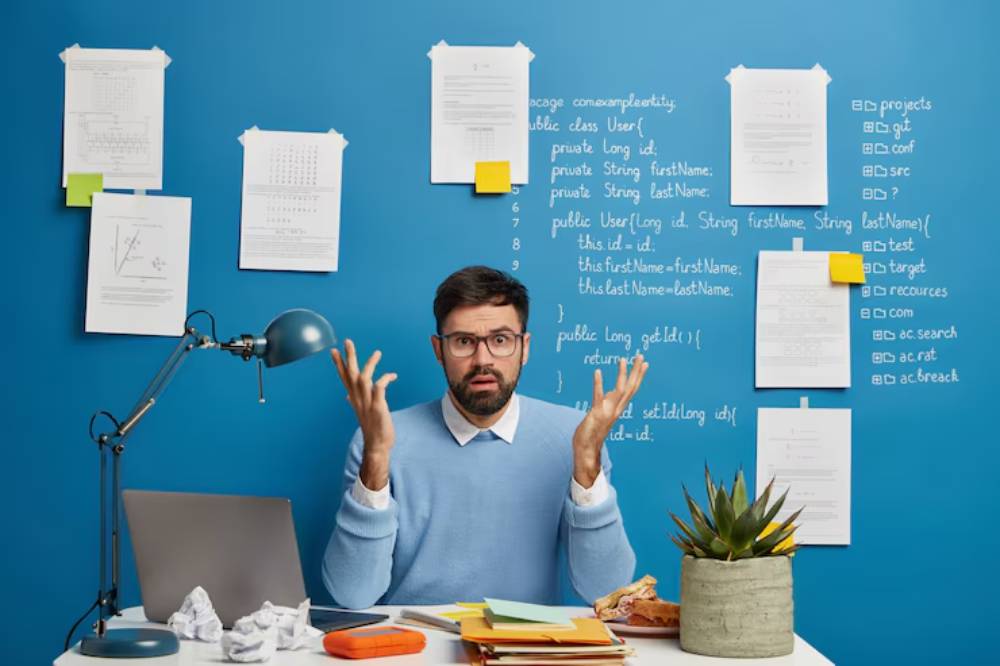The Health & Wellness Blog

Balancing Work and Screen Time in the Digital Age
In today’s fast-paced digital world, work and personal life often blend together. With more of us working remotely and relying on digital tools, screens have become central to our everyday lives. We spend a lot of time in front of screens. Whether we’re answering emails, in video meetings, or just relaxing with TV and social media, screens are a big part of our day.
While technology has certainly made our lives more convenient, it also comes with challenges. One of the biggest is managing our screen time effectively. Too much screen exposure can lead to both physical and mental exhaustion. In this blog, we’ll look at balancing work and screen time. We’ll discuss why it’s important and share practical steps to protect your well-being in today’s digital world.
Why Balancing Screen Time Matters
Physical and Mental Health Impacts
Staring at a screen for long periods can strain your eyes, cause headaches, and disturb your sleep patterns. Blue light from screens can mess with your sleep cycle, especially at night. This makes it tough to fall asleep and impacts how well you sleep.
Mentally, always being connected can lead to stress, anxiety, and even burnout. The pressure to respond instantly to work messages, keep up with news, or remain active on social media can be overwhelming. Without boundaries, it becomes difficult to truly switch off and relax.
Maintaining a Healthy Work-Life Balance

One of the most significant benefits of managing screen time is that it helps you maintain a healthy work-life balance. When work hours spill into evenings or weekends, personal time gets pushed aside. This not only reduces the time available for rest, family, and hobbies but also leads to reduced productivity and motivation over time.
Using screens mindfully can free up time for offline activities. You can read a book, take a walk, or enjoy time with loved ones.
Real-Life Scenarios: Screen Time Challenges
Let’s take the example of someone working from home. Their day may begin with checking emails. Then, they have non-stop virtual meetings. Lunch is quick and eaten at the desk. In the evening, they face project deadlines. Even after work, they may unwind by watching streaming platforms or scrolling through social media.
Without boundaries, it becomes easy to spend the entire day and evening on screens. Over time, this routine can lead to fatigue, lack of motivation, and emotional exhaustion. However, small changes can make a big difference.
For example, having set work hours, taking breaks from screens, and enjoying non-digital hobbies after work can lower screen time and restore balance.
Best Practices for Managing Screen Time
Here are some expert-approved tips that can help you take control of your screen time:
1. Set Clear Boundaries
Create a schedule with fixed working hours and stick to it. Let colleagues and clients know your availability so there’s no pressure to reply to messages late at night or on weekends.
Use calendar reminders to block time for breaks and offline activities. This can help you stick to your plan and prevent screen time from creeping into your personal hours.
2. Prioritise and Plan Tasks

Organise your day by setting priorities. Tackle the most important and energy-consuming tasks during your peak productivity hours. This allows you to complete key work more efficiently and reduces the temptation to work overtime.
Avoid spending too much time on emails or minor tasks that can easily expand and eat into your entire day.
3. Take Regular Breaks
The Pomodoro Technique is a popular method that encourages you to work in short bursts, typically 25 minutes, followed by a 5-minute break. After four rounds, take a longer break of 15–30 minutes. This technique not only boosts focus but also gives your eyes and mind a chance to rest.
During breaks, avoid switching to another screen. Instead, stretch, take a walk, hydrate, or do a quick chore. Anything that allows you to move and refresh yourself away from a device is helpful.
4. Use Screen Time Monitoring Tools
Several apps and digital tools can track how much time you’re spending on your devices. These apps give insights into usage patterns and offer suggestions for cutting down.
Some even provide gentle reminders to take breaks or block distracting sites during work hours. This is especially useful for those who find themselves habitually checking social media or news sites during the day.
Common Mistakes and How to Avoid Them

Despite the best intentions, many people make errors when trying to manage screen time. Here are some frequent mistakes to watch out for:
Skipping Breaks
It may seem harmless to power through your work without breaks, but over time, this takes a toll on your concentration and energy. Always take short, regular breaks to rest your eyes, stretch your muscles, and reset your mind.
Multitasking on Screens
Doing many tasks at once—like watching a video and replying to emails—can hurt your productivity and make you feel tired. Focus on one task at a time. This improves the quality of your work and reduces unnecessary screen time.
Forgetting Physical Activity
A sedentary lifestyle is one of the hidden risks of screen-heavy work routines. Aim to include physical activity in your day. Whether it’s a morning walk, an at-home workout, or cycling to run errands, movement is essential for both physical and mental well-being.
Not Unplugging After Work
When work ends, make a conscious effort to disconnect from devices. Avoid checking emails, logging back in, or spending too much time on social media. Set a ‘digital curfew’ at least one hour before bedtime to improve sleep quality.
Insights from Industry and Experts
What Companies Are Doing
Many forward-thinking companies are now adopting digital wellness practices. These include:
- Introducing no-meeting days
- Encouraging screen-free lunch hours
- Providing flexible working schedules
- Promoting mental health days
Some businesses also provide workshops on managing screen time and mental health. They know that employee well-being directly affects productivity and retention.
The Rise of the Digital Detox
A digital detox involves intentionally stepping away from all digital devices for a set period—be it a few hours, a day, or even an entire weekend. The goal is to reset your mind, reduce stress, and reconnect with the real world.
Experts recommend doing a digital detox regularly. Even a short break can help reduce dependency on devices and remind you of the joys of offline living.
Understanding Blue Light and Sleep
Blue light from screens can suppress melatonin, the hormone that helps regulate sleep. To combat this:
- Use blue light filters on your devices
- Try blue light-blocking glasses
- Avoid screens at least one hour before bed
Some smartphones and laptops offer built-in ‘night mode’ features that reduce blue light exposure in the evening.
Creating a Screen-Healthy Environment
How your workspace is set up also affects your screen habits. Here’s how to make it more screen-friendly:
- Use an ergonomic chair and desk to reduce physical strain
- Keep screens at eye level to prevent neck and back pain
- Use natural lighting where possible to reduce eye strain
- Keep your workspace tidy to avoid distractions
Additionally, setting up a separate area for work can help create mental boundaries between work and leisure time.
Conclusion: Finding Harmony Between Work and Screen Time
Finding a balance between work and screen time is not only possible—it’s essential. In a world where digital tools are everywhere, taking care of your mental and physical health should be a priority. Set clear boundaries, take regular breaks, and create screen-free habits. This way, you can enjoy technology’s benefits without it controlling your life.
Start today by reviewing your daily screen habits. Are you spending more time on devices than you’d like? Could you benefit from unplugging during meals, breaks, or evenings?
Remember, the goal isn’t to eliminate screens—it’s to use them wisely. Being mindful and intentional helps you build a healthier relationship with technology. This way, you can enjoy a more balanced and fulfilling life.









